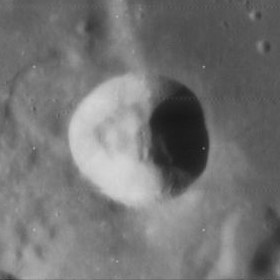 Lunar Orbiter 4 image | |
| Coordinates | 12°24′S48°12′E / 12.4°S 48.2°E |
|---|---|
| Diameter | 17 km |
| Depth | 2.2 km |
| Colongitude | 312° at sunrise |
| Eponym | Joseph R. Bellot |



Bellot is a small lunar impact crater that is located on the southwest edge of Mare Fecunditatis. It lies between the craters Goclenius to the northwest and Crozier to the southeast. To the southwest is Colombo, and to the west is Magelhaens.
This crater is circular and bowl-shaped, with a small interior floor with inner sides that slope down relatively smoothly to the bottom. The inner walls have a higher albedo than the nearby lunar mare.
